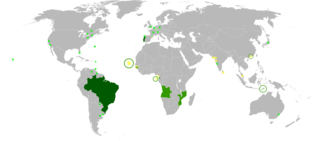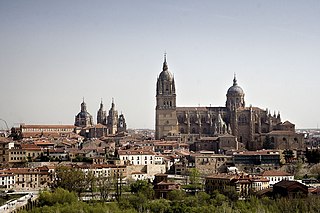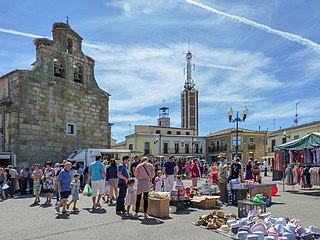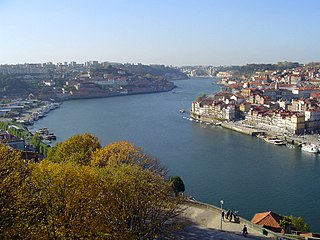
The Douro is one of the major rivers of the Iberian Peninsula, flowing from its source near Duruelo de la Sierra in Soria Province across northern-central Spain and Portugal to its outlet at Porto.

REFER, Rede Ferroviária Nacional, EP was the Portuguese rail infrastructure manager. It was a state-owned company and was created to manage the Portuguese rail infrastructure, previously under control of CP, which became exclusively a train service operator.
The CP Urban Services network is the commuter train network of Metropolitan Lisbon and Metropolitan Porto, Portugal. It connects the city centers with the suburbs.

Ermesinde is a civil parish in the municipality (concelho) of Valongo, in continental Portugal, 9 kilometres (5.6 mi) northeast of Porto. The population in 2011 was 105,897, in an area of 7.65 km². It is the smallest by area, and the densest by population.

Linha do Vouga(the Vouga line) is the last surviving metre gauge railway line in Portugal still operated by Comboios de Portugal. The other remaining metre gauge lines all closed in 2009. The line is, however, also under the threat of closure.
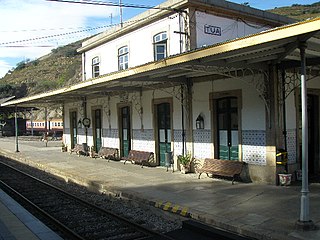
The Tua Railway Station (Portuguese: Estação Ferroviária do Tua is northern Portuguese railway station located in the civil parish of Castanheiro do Norte e Ribalonga, in the municipality of Carrazeda de Ansiães, close to the confluence of the Douro and the Tua. Although the station is still served by Comboios de Portugal main line trains on the Douro line to/from Porto.

Carviçais is a parish of the municipality of Torre de Moncorvo in the district of Bragança (Portugal). The population in 2011 was 757, in an area of 63.00 km². The parish is composed of 7 villages: Carviçais, Macieirinha, Martim Tirado, Quinta da Estrada, Quinta das Pereiras, Quinta das Peladinhas and Quinta da Nogueirinha.

The history of rail transport in Portugal dates from 28 October 1856, when Portugal's first railway line was opened between Lisbon and Carregado: the Companhia dos Caminhos de Ferro Portugueses.

The Tua line was a metre gauge railway line in northern Portugal, which connected Tua to Bragança. The line was opened in 1887 and closed in 2018. The section from Mirandela to Brunheda is planned to be reopened in 2019.

The Corgo line(Linha do Corgo) was a 1,000 mmmetre gauge railway line in northern Portugal. It closed in 2009. It ran north from Régua to Vila Real and Chaves. The line was latterly operated by Comboios de Portugal.

The Dão line was a metre gauge railway line in Portugal. It ran close to the Dão River, between Santa Comba Dão and Viseu.

Linha de Guimarães is a railway in Portugal operated by Comboios de Portugal. It runs between Oporto (Porto) and Guimarães; until 1986 it extended eastwards to Fafe. It was extensively modernised in the 2000s, including conversion from metre gauge to Iberian gauge track and electrification.
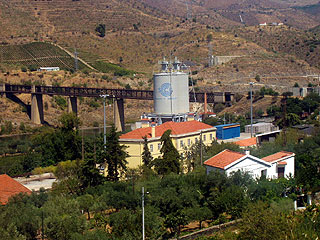
The Sabor line(Linha do Sabor) was a 1,000 mmmetre gauge railway in north-east Portugal. It ran for nearly 106 km between Pocinho and Duas Igrejas, near Miranda do Douro. It closed in 1988.

Portugal formerly had several hundred kilometres of narrow-gauge railways, but by 2010 only two lines were still in operation – the Vouga line and the Metro de Mirandela. The lines were operated by Comboios de Portugal and maintained by REFER.

The Barca d'Alva–La Fuente de San Esteban railway is a closed Iberian gauge line which connected Barca d'Alva on the Linha do Douro, in northeastern Portugal, to the Spanish railway network. Passenger and cargo trains ran from Porto to Salamanca until its closure in 1985.
Infraestruturas de Portugal, S.A. (IP) is a state-owned company which resulted from the merger of Rede Ferroviária Nacional (REFER) and Estradas de Portugal (EP). It manages the Portuguese rail and road infrastructure.

Ramal de Aveiro is a Portuguese metre gauge railway line operated by Comboios de Portugal. It connects Aveiro and Sernada, where it connects with Linha do Vouga.



